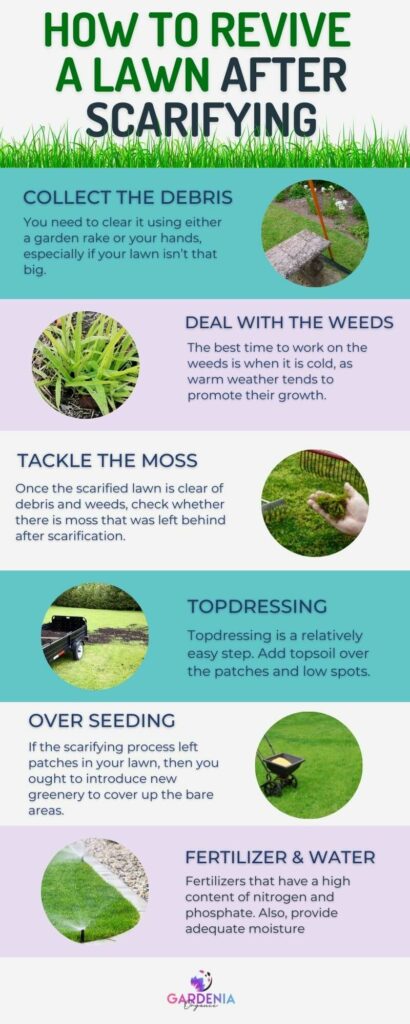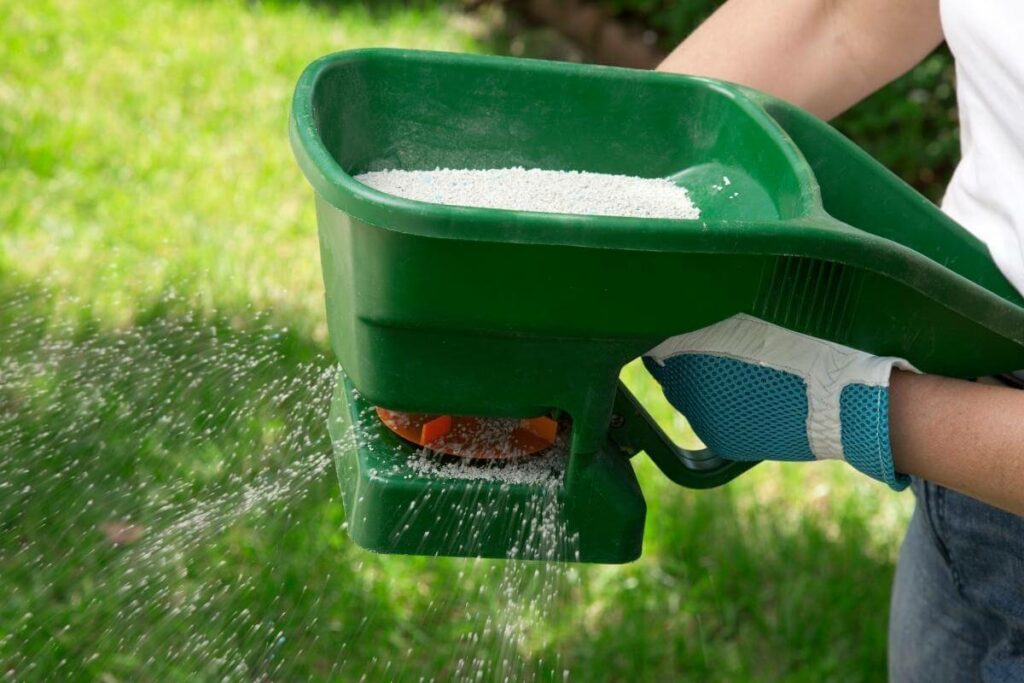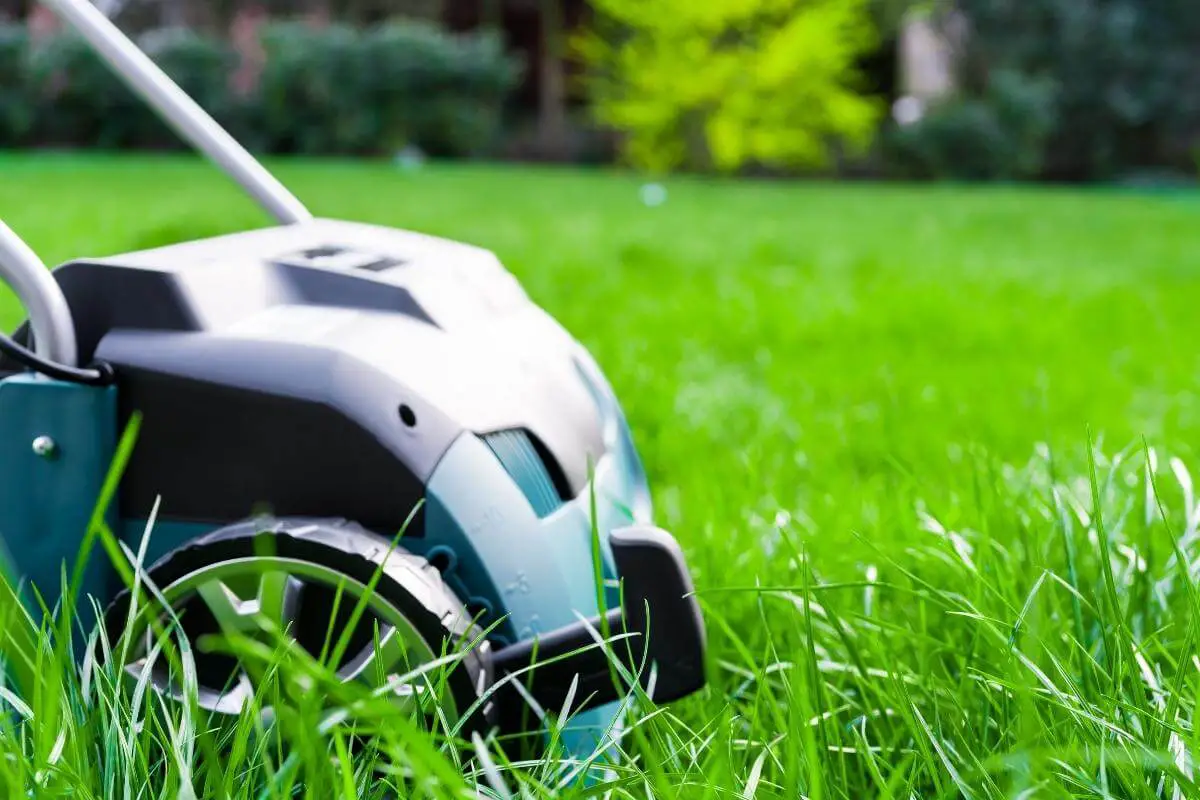If you want your lawn to look lush and green all year long, then scarifying it should be part of your maintenance routine.
Even though it leads to a healthier lawn, the immediate aftermath of scarifying, just as the first part of the word, is scary. Therefore, you will naturally want your lawn to recover as fast as possible.
For this to happen, you ought to keep in mind that timing is everything. Scarifying your lawn when the weather is sunny, warm, with a bit of rain will speed up the lawn’s recovery after scarifying.
That is why autumn is the best time to scarify your lawn. Other than that, there are things that you can do to help with the process.
What You Will Learn: In this article, we will highlight the steps you should take to revive a lawn after scarifying. Before that, let’s look at why you need to scarify your lawn every once a year or so.
How Does Scarifying Contribute to A Healthy Lawn?

Over time, thatch and moss gather around a lawn, making it hard for green grass to grow and thrive, resulting in a spongy and unhealthy lawn. This is where scarifying comes in. Gardeners or lawn owners scarify to remove the build-up of thatch and dead moss from the surface of the lawn.
Thatch, dead moss, and weeds have adverse effects on a lawn:
- For one, they suffocate new grass shoots preventing them from emerging from the soil.
- Secondly, they prevent nutrients and water from reaching and penetrating the soil. The build-up of thatch and dead moss also promotes lawn diseases like mold and the infestation of pests.
- Thirdly, scarifying helps to prevent the above scenarios and, in turn, keep your lawn as lovely as you want it to be. However, as we have stated, the immediate aftermath of scarifying can be quite unsightly.
It can leave bare patches on the ground and unattractive brown grass in some areas. So how can you revive a lawn after scarifying?
Steps To Revive Your Lawn After Scarifying

Collect the Debris
Once you are done scarifying, there will be debris lying all over the lawn. You need to clear it using either a garden rake or your hands, especially if your lawn isn’t that big. Collecting debris manually on a sizeable lawn can be backbreaking.
In this case: It would be wise to get a scarifier with a collection box to pick up the debris as you scarify. You can recycle the green garden debris by putting it into a compost pit.
Deal with the Weeds
If there are weeds in the lawn, get rid of them by either uprooting them or using weed killers that are friendly to the lawn.
The best time to work on the weeds is when it is cold, as warm weather tends to promote their growth.
Tackle the Moss
Once the scarified lawn is clear of debris and weeds, check whether there is moss that was left behind after scarification.
If there is, use moss killers such as doses of ferrous sulfate-based moss killer to eliminate the remaining moss.
Smart Thing to Do: You could apply the moss killer by spraying it or by using a watering can. Either way, it should be able to penetrate the moss and kill it.
Topdressing
Places, where a lot of thatch has been removed, could leave bare patches.
Similarly, there could be low spots in areas where moss and weeds have been removed. That’s why it is important to top-dress so that the lawn is level again.
Topdressing is a relatively easy step. At times, all you need to do is add topsoil over the patches and low spots until your lawn is nice and even again.
Moreover, it introduces more nutrients and microbes to the soil. Even so, top dressing is an optional step as it may cost you time and money.
Over seeding
If the scarifying process left patches in your lawn, then you ought to introduce new greenery to cover up the bare areas.
You can achieve this by sprinkling seeds into the areas of the lawn that you need new grass to grow. This is what we mean by overseeding.
Overseeding is good for replacing lost grass and preventing weeds and other unwanted plants from growing in those bare patches. Furthermore, if you leave the area without grass, your lawn will not look as good as you would like.
Avoid This: When buying grass seeds, ensure that you get seeds that are a close match to the grass that you already have. You don’t want to have varying shades of grass on the same lawn.
Use Lawn Fertilizer

Lawn fertilizer promotes and hastens the germination of new grass seeds. On top of that, it provides the existing grass with additional nutrients that encourage growth and repair.
Fertilizers that have a high content of nitrogen and phosphate tend to be relatively more multi-purpose; that is, on top of growth, they promote repair and health of the grass.
Moreover, the best lawn fertilizer to apply on your scarified lawn will depend on the time of the year. During autumn, use autumn fertilizer. They work at a slow rate but ensure the grass is healthy and grows steadily during the cold months.
During spring, it is best if you apply springtime fertilizer on your scarified lawn. It will encourage rapid grass growth during the period.
Ensure the Lawn has Enough Water
The soil will need adequate moisture to activate the fertilizer and enable it to work effectively on the grass seeds.
If you scarify during autumn or spring, then you will have rainwater to fall back on. The rainwater will be enough to keep your lawn moist enough.
However, if it is not rainy season, then you ought to water the lawn yourself at least once a day. If it is sunny, then the best time of day to do the watering is in the evening when the rays of the sun are not beating down on the new grass.
To Consider: It would be a good idea to invest in a hose that has a fine sprinkler. This will protect the grass seeds from getting washed away as they would if you watered heavily on them.
How Long Does It Take a Scarified Lawn to Recover?
Generally, it takes anywhere between 4 to 6 weeks for a scarified lawn to recover fully.
However, this is if you take the steps highlighted above to help with the process. Otherwise, your lawn will take so much longer to achieve the look that you desire.
Also, remember that the timing can also affect the speed at which a lawn recovers after scarification. It is advisable to scarify your lawn during autumn when it is warm and rainy, as it helps your lawn grow back faster.
Final Words
A scarified lawn is not the prettiest sight to behold. It is patchy, uneven, and quite disorganized. As a lawn owner, you would want your lawn to get back to its healthy form as soon as possible.
To make this happen, there are steps that you can take to promote the process. They include clearing the debris after scarification, getting rid of weeds and moss, topdressing, overseeding, applying fertilizer and keeping the lawn watered sufficiently.
Timing is also important when it comes to scarifying a lawn. You want to do it when it is warm and rainy, which is why autumn or mid-spring are the best times. Usually, it takes 4 to 6 weeks to fully revive a lawn after scarifying.
